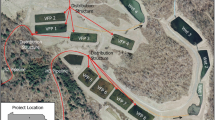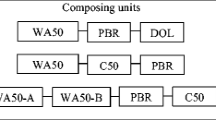Abstract
During the 1990s, passive treatment technology was introduced to the United Kingdom (UK). Early hesitancy on the part of regulators and practitioners was rapidly overcome, at least for net-alkaline mine waters, so that passive treatment is now the technology of choice for the long-term remediation of such discharges, wherever land availability is not unduly limiting. Six types of passive systems are now being used in the UK for mine water treatment:
-
♦ aerobic, surface flow wetlands (reed-beds);
-
♦ anaerobic, compost wetlands with significant surface flow;
-
♦ mixed compost/limestone systems, with predominatly subsurface flow (so-calledReducing andAlkalinityProducingSystems (RAPS));
-
♦ subsurface reactive barriers to treat acidic, metalliferous ground waters;
-
♦ closed-system limestone dissolution systems for zinc removal from alkaline waters;
-
♦ roughing filters for treating ferruginous mine waters where land availability is limited.
Each of these technologies is appropriate for a different kind of mine water, or for specific hydraulic circumstances. The degree to which each type of system can be considered “proven technology” corresponds to the order in which they are listed above. Many of these passive systems have become foci for detailed scientific research, as part of a $1.5M European Commission project running from 2000 to 2003.
Similar content being viewed by others
References
Anderson RF, Schiff SL (1987) Alkalinity generation and the fate of sulfur in lake sediments. Canadian Journal of Fisheries and Aquatic Sciences, 44 (1): 188–193.
Bannister AF (1997) Lagoon and reed-bed treatment of colliery shale tip water at Dodworth, South Yorkshire. In Younger PL (ed) Minewater Treatment Using Wetlands. Proc of a National Conf, University of Newcastle, UK. Chartered Institution of Water and Environmental Management, London, pp 105–122.
Benner SG, Blowes DW, Ptaceck CJ (1997) A fullscale porous reactive wall for prevention of acid mine drainage. Ground Water Monitoring and Restoration (Fall 1997), pp 99–107.
Edwards PJ, Bolton CP, Ranson CM, Smith AC (1997) The River Pelenna minewater treatment project. In: Younger PL (ed.), Minewater Treatment Using Wetlands. Proc of a National Conf, University of Newcastle, UK. Chartered Institution of Water and Environmental Management, London, pp 17–32.
Hamilton QUI, Lamb HM, Hallett C, Proctor JA (1997) Passive treatment systems for the remediation of acid mine drainage Wheal Jane, Cornwall, UK. In: Younger PL (ed.) Minewater Treatment Using Wetlands. Proc of a National Conf, University of Newcastle, UK. Chartered Institution of Water and Environmental Management, London, pp 33–56.
Hedin RS, Nairn RW, Kleinmann RLP (1994) Passive Treatment of Coal Mine Drainage. U.S. Bureau of Mines I.C. 9389, 35 pp.
Jarvis AP, Younger PL (1999) Design, construction and performance of a full-scale wetland for mine spoil drainage treatment, Quaking Houses, UK. Journal of the Chartered Institution of Water and Environmental Management, 13: 313–318.
Jarvis AP, Younger PL (2000) Rapid removal of iron from net-alkaline minewaters using high specific surface area media. South African Journal of Science_(in review).
Kemp P, Griffiths J (1999), Quaking Houses. Art, Science and The Community: A collaborative approach to water pollution. Jon Carpenter Publishing, Charlbury, Oxon. 142 pp.
Kepler DA, McCleary EC (1994) Successive Alkalinity Producing Systems (SAPS) for the Treatment of Acidic Mine Drainage. Proc of the International Land Reclamation and Mine Drainage Conf and the 3rd International Conf on the Abatement of Acidic Drainage. (Pittsburgh, PA). Vol 1, pp 195–204.
Laine DM (1997) The treatment of the pumped minewater discharge at Wooley Colliery, West Yorkshire. In: Younger PL (ed.) Minewater Treatment Using Wetlands. Proc of a National Conf, University of Newcastle, UK. Chartered Institution of Water and Environmental Management, London, pp 83–103.
Laine DM (1998) The treatment of pumped and gravity minewater discharges in the UK and an acidic tip seepage in Spain. Proc of the International Mine Water Association Symp, Johannesburg, South Africa. (Vol II), pp. 471–490.
Marsden M, Kerr R, Holloway D, Wilbraham D (1997) The position in Scotland. In: Brid L (ed.) Proc of the UK Environment Agency Conf on Abandoned Mines: Problems and Solutions, University of Sheffield, pp. 74–84.
National River Authority (1994) Abandoned mines and the water environment. Report of the National Rivers Authority. Water Quality Series No 14. London, HMSO, 46pp.
Norton PJ, Norton CJ, Tyrrell W (1998) The design, construction and cost of an engineered wetland for treatment of acid drainage from sulphide mineral-rich strata. In: Proc of the International Mine Water Association Symp, Johannesburg, South Africa. (Vol. II), pp. 425–432.
Nuttall CA, Younger PL (1999) Reconnaissance hydrogeochemical evaluation of an abandoned Pb−Zn orefield, Nent Valley, Cumbria, UK. Proc of the Yorkshire Geological Society, 52, pp 395–405.
Nuttall CA, Younger PL (2000) Zinc removal from hard circum-neutral mine waters using a novel closed-bed limestone reactor. Water Research, 34: 1262–1268.
Parker K (1997) Minewater—the First Two Years of the Coal Authority. In: Bird L (ed.) Proc of the UK Environment Agency Conf on Abandoned Mines: Problems and Solutions, University of Sheffield, pp 154–161.
Ranson CM, Edwards PJ (1997) The Ynysarwed experience: active intervention, passive treatment and wider aspects. In: Younger PL (ed.) Minewater treatment using wetlands. Proc of a National Conf, University of Newcastle, UK. Chartered Institution of Water and Environmental Management, London. pp 151–164.
Tarutis WJ, Stark LR, Williams FM (1999) Sizing and performance estimation of coal mine drainage wetlands. Ecological Engineering, 12: 353–372.
Walton-Day K (1999) Geochemistry of the processes that attenuate acid mine drainage in wetlands. In: Plumlee GS, Logsdon MJ (eds) The environmental geochemistry of mineral deposits. Reviews in Economic Geology, Volume 6A, Society of Economic Geologists, Littleton, CO, pp 215–228.
Warner I (1997) Oatlands Colliery—West Cumbria. In: Bird L (ed.), Proc of the UK Environment Agency Conf on “Abandoned Mines: Problems and Solutions”. University of Sheffield, pp 40–51.
Wood SC, Younger PL, Robins NS (1999) Longterm changes in the quality of polluted minewater discharges from abandoned underground coal workings in Scotland. Quarterly Journal of Engineering Geology, 32: 69–79.
Younger PL (1993) Possible Environmental Impact of the Closure of Two Collieries in County Durham. Journal of the Institution of Water and Environmental Management, 7: 521–531.
Younger PL (1995) Hydrogeochemistry of minewaters flowing from abandoned coal workings in the Durham coalfield. Quarterly Journal of Engineering Geology, 28(4): S101-S113.
Younger PL (1997a) The Longevity of Minewater Pollution: A Basis for Decision-Making. Science of the Total Environment, 194/195: 457–466.
Younger PL (1997b) Minewater Treatment Using Wetlands. Proc of a National Conf, University of Newcastle, UK. Charatered Institution of Water and Environmental Management, London. 189pp.
Younger PL (1997c) The future of passive minewater treatment in the UK: a view from the Wear Catchment. In: Younger PL (ed.), Minewater Treatment Using Wetlands. Proc of a National Conf, University of Newcastle, UK. Chartered Institution of Water and Environmental Management, London. pp. 65–81.
Younger PL (1998a) Coalfield Abandonment: Geochemical Processes and Hydrochemical Products. In: Nicholson K., Energy and the Environment. Geochemistry of Fossil, Nuclear and Renewable Resources. Society for Environmental Geochemistry and Health. McGregor Science. Aberdeenshire, pp 1–29.
Younger PL (1998b) Design, construction and initial operation of full-scale compost-based passive systems for treatment of coal mine drainage and spoil leachate in the UK. Proc of the International Mine Water Association Symp, Johannesburg, South Africa. (Vol. II), pp. 413–424.
Younger PL (2000a) Mine water pollution in Scotland: nature, extent and preventative strategies. Science of the Total Environment.
Younger PL (2000b) Mine water pollution in the long-abandoned Cleveland Ironstone Field, north-east England. Proc of the 7th National Hydrology Symp, British Hydrological Society. Newcastle Upon Tyne, UK.
Younger PL, Harbourne KJ (1995) “To pump or not to pump”: Cost-benefit analysis of future environmental management options for the abandoned Durham Coalfield. Journal of the Chartered Institution of Water and Environmental Management, 9(4): 405–415.
Younger PL, Curtis TP, Jarvis AP, Pennell R (1997) Effective passive treatment of aluminium-rich, acidic colliery spoil drainage using a compost wetland at Quaking Houses, County Durham. Journal of the Chartered Institution of Water and Environmental Management, 11: 200–208.
Younger PL, Large ARG, Jarvis AP (1998) The creation of floodplain wetlands to passively treat polluted minewaters. In: Wheater H, Kirby C (eds.), Hydrology in a Changing Environment. (Proc of International Symp organised by the British Hydrological Society, Exeter, UK). Volume I. pp 495–515.
Author information
Authors and Affiliations
Rights and permissions
About this article
Cite this article
Younger, P.L. The adoption and adaptation of passive treatment technologies for mine waters in the United Kingdom. Mine Water and the Environment 19, 84–97 (2000). https://doi.org/10.1007/BF02687257
Issue Date:
DOI: https://doi.org/10.1007/BF02687257




